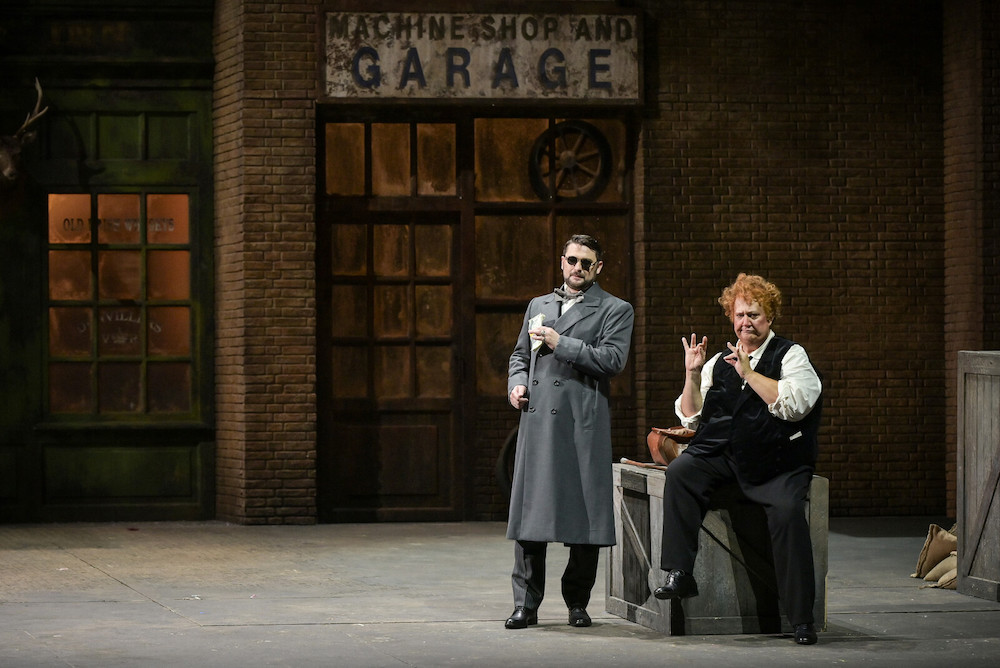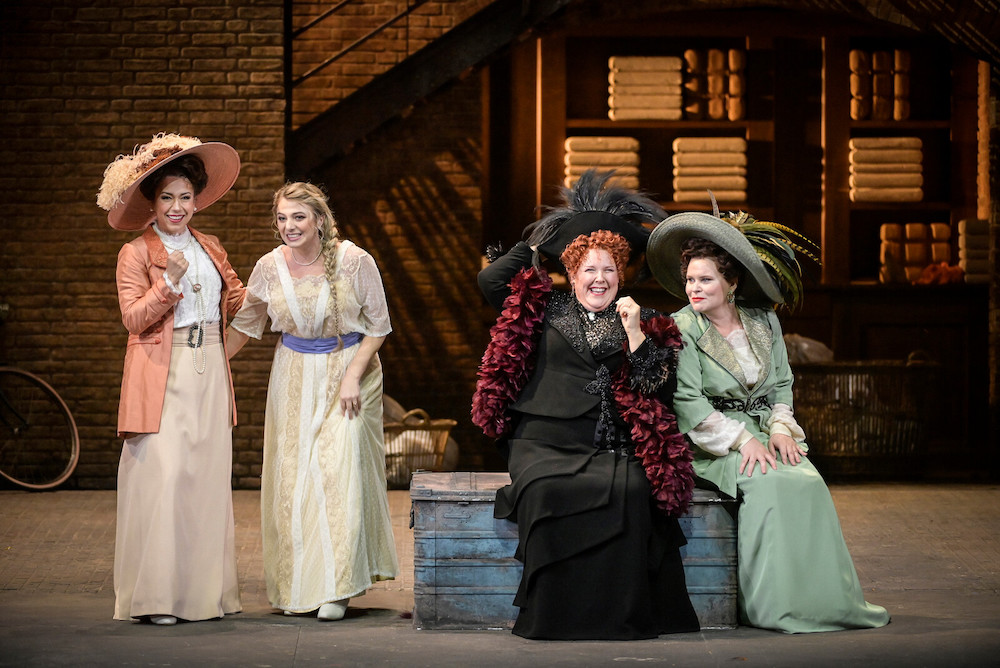It was magic from the start, Verdi’s in medias res chords exploded and tumbled, Danish conductor Michael Schønwandt established the solid, brisk beat, brilliantly illuminating Verdi’s vast musical complexities to their final cadence.
Verdi’s unparalleled masterpiece shone in its comic majesty, integrated into French stage director Dominique Pitoiset’s once progressive, now venerable 1999 production. Pitoiset had staged a series of Shakespeare plays for progressive theaters in Milan and Torino that caught the eye of Hugues Gall, the then (1995-2004) general director of the Opéra de Paris. Paris Opera had already celebrated the famed Italian theater director Giorgio Strehler, thus it was an evident choice to tap a director imbued in pristine progressive Italian theater to stage this prestigious Italian Shakespeare knock-off.
Pitoiset set the opera in front of a giant, late Victorian, industrial façade fronting the Quickley Steam Laundry, together with the ubiquitous British pub, an entry point for visits to Windsor Park and its famed tree, and an automobile repair garage which contained a classic British roadster. To change the scenes the huge façade magically traversed the stage — a vista! — moving on and off the stage to reveal its various components in different configurations. Wittily, the huge wall arrived finally at the black oak, its final destination, and stopped, at which point the car, evidently finally repaired, then drove off the stage.
All this was possible because the then new Opéra Bastille boasted massive wing space.

The massive wall made a parallel, always lively, always witty world to what Verdi’s famed librettist, Arrigo Boito made of Shakespeare’s tale. Director Pitoiset respected the Italian makeover to the letter. The play itself was downstage, its characters in high relief, its towering Falstaff was portly indeed. Falstaff’s tormentors, Bardolfo and Pistola effected slick Goldoni physical theater à la Strehler, complementing the commedia dell’arte, clownlike wigs of Falstaff and Pistola. The plotting women were carefully grouped together to deliver their tricky music in highly theatrical poise. Nanetta and Fenton flitted airily across the stage. And finally Ford was left quite alone on the darkened stage to vent his cuckolded rage.
The action moved always in slickly theatrical terms, all ten principals in swift, highly directed, chaotic motion that was the second act finale, arriving finally in a line across the front of the stage to summon the final musical confusion, at which point Falstaff was dumped into the steaming river.
The Opéra de Paris enlisted a splendid cast. That they were of big, beautiful voice was a bonus, given the amplitude of the Opéra Bastille, its mighty orchestra revved up to deliver the Verdi masterpiece with maximum energy. Italian baritone Ambrogio Maestri as the Falstaff. It is his signature role, first performed at La Scala in 2001, performed as well in the 2013 incarnation of the Pitoiset Falstaff at the Bastille. Mr. Maestri earned an impromptu ovation for his roar of indignation at the very idea of “honor,” but later found a great beauty of tone and phrasing in his humiliated “Mondo ladro, mondo rubaldo, reo mondo,” achieving finally an actual nobility of tone for a capitulatory “Tutto nel mondo è burla.”
Ford was sung by Ukrainian baritone Andrii Kymach. Of sharply focused, golden hued voice Mr. Kymach has an intense, dark-eyed presence. He tore up the stage with his “È sogno o realta … due rami enormi,” easily slipping into Ford’s blinding rage, then succumbing into a pure opera buffa victim of his own cunning as the pater familias.
Peruvian tenor Iván Ayón Rivas lent very beautiful, ample lyric tenor voice to Fenton, easily finding the exquisite beauty Verdi imbued into his Act III “Dal labbro il canto estasiato vola.” Nannetta was sung by Italian soprano Federica Guida in ample, Italianate lyric tone that added considerable musical and dramatic heft to her fairy queen masquerade “Sul fil d’un soffio etesio ”
The heavier voices of Mr. Rivas and Mme. Guida as they played out their love story in this performance added enormous emotional warmth and dramaturgical reward, equalling in impact the comic comeuppances of Falstaff and Ford, and the warmth of Falstaff’s acceptance of the absurdity of his existence.
Conductor Schønwandt underscored the absolute absurdity of the opera by giving us at last a carefully paced fugue, each of its voices entering in absolute clarity, emerging finally, somehow, in Verdi’s maelstrom of magnificent musical turmoil.

Alice Ford was sung by American soprano Olivia Boen with great warmth of voice, and sense of comic timing. Mistress Quickly was sung by Canadian contralto Marie-Nicole Lemieux in a performance that was fully, and beautifully sung with but little trace of the caricature that is usual for this sometimes character role. Mrs. Meg Page was sung by French mezzo-soprano Marie-Andrée Bouchard-Lesieur, Meg’s usual aplomb pointedly exaggerated.
Bardolfo was sung by agile Australian character tenor Nicholas Jones who tumbled gracefully in a nod to Goldoni, Pistola, the driver of the classic roadster, was sung by Italian bass Alessio Cacciamani in booming voice (lead photo with Falstaff). Dr. Cajus was rendered by Italian character tenor Gregory Bonfatti as total caricature, betraying the purer dramaturgy of the production.
Michael Milenski
Scenery was designed by Alexandre Beliaev, costumes by Elena Rivkina. The original lighting was designed by Philippe Albaric, adapted by Christophe Pitoiset both in 2017 and just now. The chorus and orchestra of the Opéra national de Paris, Opéra Bastille, Paris, France, September 10, 2024.
All photos copyright Vincent Pontet, courtesy of the Opéra de Paris